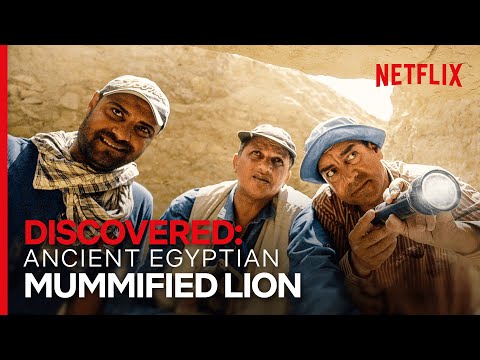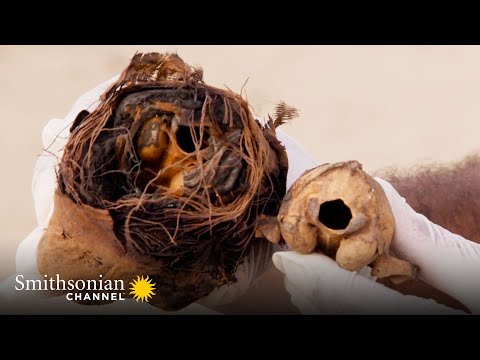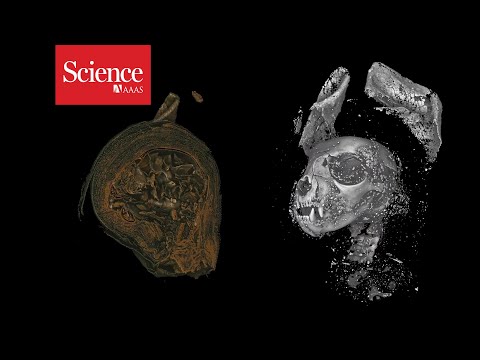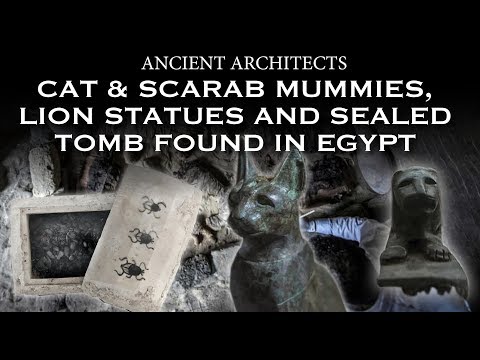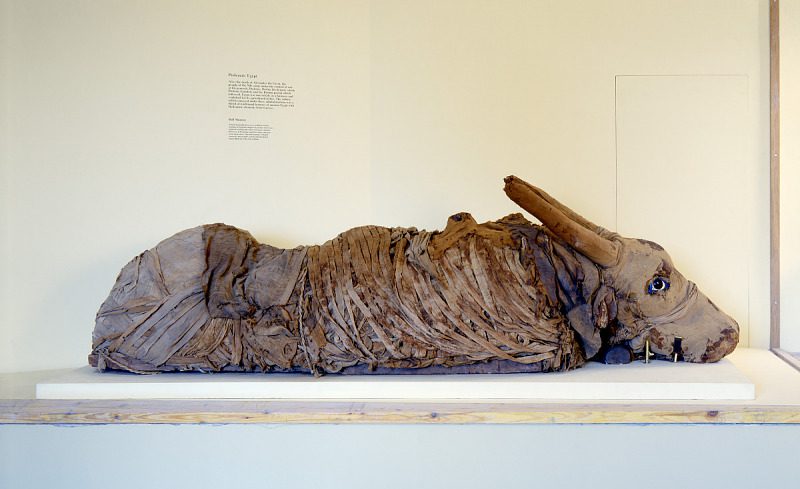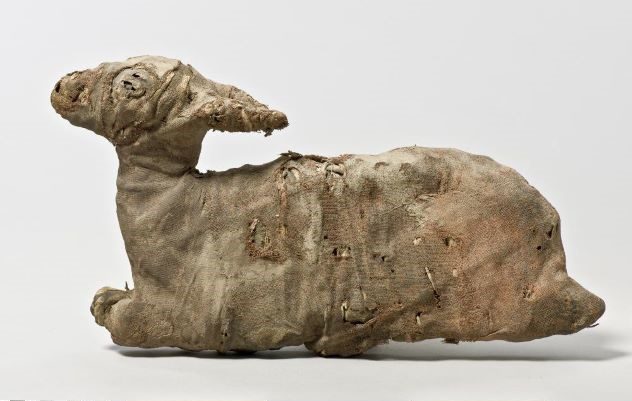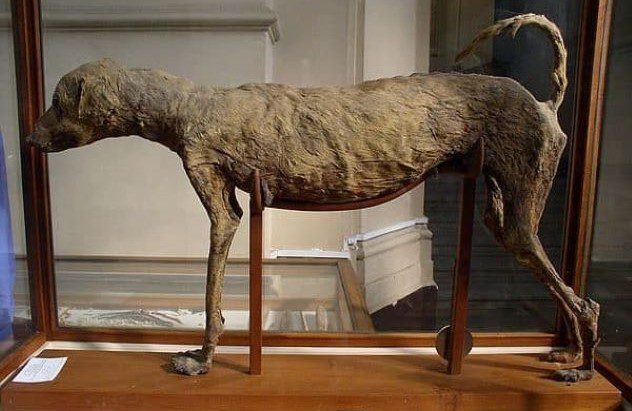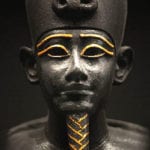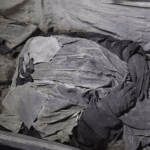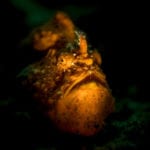From sacrifices made to the gods to pets buried together with their owners, the eventual nationwide mania around the animal mummification industry came to require such large numbers of live animals that large-scale farms, resources, and extra staff to breed and look after an incredible range of animals almost became the norm. Over 70 million animals were mummified and buried in Egypt’s catacombs. We thought it would be interesting to take a look at some of the most incredible mummified animals discovered so far.
10 The Crocodile Mummy
The ancient Egyptians revered crocodiles as the manifestation of the crocodile god Sobek, and hundreds were mummified after their death. The nationwide supply and demand for mummified crocodiles were significant in ancient Egypt. Tens of thousands were bred and held in captivity only to be put to death and expertly mummified as sacrifices to the gods. Archaeologists also recently confirmed what has been suspected for a long time, that crocodiles were stalked and hunted, a truly hazardous pastime, to help sustain the frenzy. Researchers in France were genuinely shocked when they discovered a massive skull fracture during a virtual necropsy on one of the crocodile mummies currently in the Musée des Confluences in Lyon, France. It was, in fact, the first evidence ever uncovered to confirm the hunting of these wild animals to be sold and turned into animal mummies.[1]
9 The Lion Mummies
Lions held a powerful status in ancient Egypt, as they were considered the most formidable hunter in the wild and an everlasting symbol of peril and protection. It is a well-known fact that Pharaohs took part in lion-hunting expeditions to display their own superiority, including Amenhotep III, who murdered at least 102 lions during the first decade of his reign. Until recently, Egyptologists have only uncovered one lion mummy, leading many to wonder if they were, in fact, very rare or whether we were looking for them in the wrong places. Finally, during an archeological dig in Saqqara in November 2019, a team of archaeologists led by the Egyptian Supreme Council of Antiquities disclosed that they had discovered five more lion mummies, believed to be cubs, in the necropolis of Bubasteion—which is literally a cat mummy catacomb. The mummified cubs are believed to have been around eight months old at the time of their death and are about 3 feet (1 meter) in length. They were uncovered along with a wide assortment of timber and bronze sculptures of cats and other mummified animals, including snakes and reptiles. The artifacts have been dated to Egypt’s 26th Dynasty—around 664–525 BC.[2]
8 The Millions of Ibis Mummies
The Ibis cult was widely observed during the Roman and Ptolemaic eras and was devoted to Thoth, the god of wisdom. Carbon dating research conducted in 2015 revealed that the Egyptian ibis mummies were all created in the period between 450 and 250 BC. The sheer amount of mummified ibises is incredible. Saqqara alone contains almost 500,000 of these mummies, and it is also believed to have obtained an additional 10,000 mummified sacrifices every year. If that figure is not staggering enough, we should all take a moment to think about the other four million ibis mummies discovered in the catacombs of Tuna el-Gebel. Ibis mummification included evisceration and desiccation. Generally, the bird’s neck and head would be bent backward and pressed back onto the body. It would then be immersed in tar and finally tightly wrapped in linen. The substantial number of mummified ibises clearly shows that it was, in all probability, done during mass production, as several of the mummies recovered contained only partial mummies with certain body parts excluded or added to other mummies. After satisfying the ceremonial purposes, the mummified bodies were inserted in clay pots, wooden coffins, and sarcophagi.[3]
7 The Numerous Cat Mummies
The Egyptians were definitely cat people. Or cat mummy people, depending on how you look at it. Domestic cats were often mummified as religious sacrifices in large amounts and were claimed to represent Bastet, the goddess of war. The cult of Bastet was located primarily around Beni Hasan and Thebes during the Ptolemaic period. Thousands of cat mummies have also been found throughout the Saqqara catacombs. Cats farmed for the sole reason of sacrifice typically died due to broken necks or strangulation. During mummification, their bodies would be left to dry and were then packed with soil, mud, or another kind of packing material. They were usually positioned in a sitting position with their limbs folded next to their bodies. The linen wrapped around their bodies was often decorated with elaborate, decorative designs. In the earlier days of cat mummification, the mummies were often placed in small bronze or timber sarcophagi. The most pricey mummies were usually decorated with facial features that would be painted on with black paint and could have obsidian, rock crystal, or even colored pieces of glass for eyes. Archeologists have also found several cat mummies that included the bodies of small kittens or fetuses buried within the adult cat. However, as time went by, the mummies became less elaborate, and mummifications lost some of their consistency.[4]
6 Saqqara’s Mummified Cobras
Times were hard if you happened to be a snake in Thebes from the late Egyptian period to Egypt’s Roman period when they were considered to be one of the sacred animals of the god Amun. They were also associated with regeneration and rebirth due to their ability to shed their skins. Many snake mummies were wrapped in linen; others were inserted into beautifully designed bronze containers and sacrificed to Atum in shrines and cemeteries. One specific cemetery, Amara West, contained a “shrine” with a string of snake burials connected to it. Although not mummified, this cemetery had hundreds of python skeletons that could possibly be linked to a Nubian snake cult. Archaeological digs at Saqqara have also uncovered several mummies containing Egyptian cobras wrapped in tight bundles. From high-tech 3D scans, researchers have been able to see spinal fractures, which the group believes occurred in a “whipping” procedure where the cobras would be held by the tail and smashed to death by beating their heads to the ground. The cobras were so well preserved that researchers could even verify significant kidney damage, which indicates that these reptiles were probably dehydrated at the time of death, demonstrating the horrible conditions in which they were kept. Even the resin placed inside their jaws could be identified, believed to have been placed there to keep their mouths open in order to be able to speak, eat, and breathe in the afterlife.[5]
5 Mummified Baboons
As god of the moon and the god of wisdom, it was probably a very high honor for baboons to represent the god Thoth. The depictions of baboons on the funerary jars that contained the significant organs of their human mummy counterparts are a testimony to the enormous religious and cultural significance of the mammals. Baboons were bred and reared in high volumes at temples, although the number of baboon mummies uncovered to date has yet to reach the figures we’ve seen with cats and ibises. About 400 baboon mummies were unearthed at the catacombs of the now-almost notorious Saqqara. Virtually all the baboons were mummified by utilizing plaster and subsequent burial in wooden chests. The baboon mummies uncovered to date have further shown compelling evidence that they were bred for the sole purpose of mummification and religious sacrifice. None of the baboons died from natural causes, and almost all of them suffered from severe fractures, osteomyelitis, malnutrition, and severe vitamin D deficiency.[6]
4 Scarab Beetles
In November 2018, archaeologists in Egypt came across an incredibly rare collection of scarab beetle mummies. Their find also included a perfectly breathtaking fifth-dynasty tomb (previously undiscovered) which they opened within the following months. The scarab beetle mummies were found with an assortment of other artifacts spread over seven tombs located on the boundary of King Userkaf’s pyramid complex in the south of Cairo. According to Egypt’s Antiquities Ministry, the breakthrough discovery included two quite significant scarab beetle mummies in cloth discovered on the inside of a limestone sarcophagus with such a beautifully decorated and vaulted lid that the whole crew was astounded by its excellent condition. A further collection of incredibly well-preserved scarab beetle mummies was discovered inside another relatively small sarcophagus. The Ministry has revealed that the finding of mummified scarab beetles is absolutely remarkable. It’s an extremely rare discovery that most archaeologists may never discover throughout their entire lives.[7]
3 Mummified Bulls
The Apis bull cult emerged as early as 800 BC and is the very first Egyptian cult that could be verified by archaeological finds. The first and most significant among all of ancient Egypt’s animal cults, the Apis bull cult, believed the bull to be a symbol of power, strength, and fertility, as it represented the creator gods Osiris and Ptah. Their ultimate mummification played a crucial part in the daily veneration of these animals. While alive, the bull was accommodated inside a distinctive shrine, luxuriously coddled during his lifetime. Priests presumed that the Apis bull was a means of interaction between the two different gods of creation, so much so that the bull’s activities and gestures were meticulously observed. It was often consulted as the cult’s oracle. The Apis bulls were allowed to die a natural death unless they reached the age of 28 years—at which point they would be sacrificed. After the death of the Apis bull, the whole nation went into mourning. It was provided with an extravagant burial accompanied by complex funerary guidelines. Because of their size, the mummification process was complex and tedious. Immense embalming tables have been discovered in Memphis, the cult’s center. These tables were beautifully engraved and even featured drainage channels. The bull’s body would have been dried through the use of natron salts and eventually crammed full of sand before being wrapped in several layers of cloth. Synthetic eyes and an aesthetic ceramic head would’ve been added as a final touch to ensure that the bull maintained its features.[8]
2 An Egyptian Queen’s Pet Gazelle
One of the most intriguing animal mummies ever found was that of an Egyptian queen’s pet gazelle. The beautifully preserved gazelle was prepared for its eternal afterlife with about the same extravagant treatment as any other member of its ancient royal family. It followed its queen to its final resting place about 945 BC, protected and swathed with delicate blue-trimmed linen and a handcrafted wooden casket. Many historians believe the gazelle probably belonged to Isetemkheb D—an Egyptian queen who lived around 1070–945 BC and was buried in the royal cache only publicly known as “DB320.” The mummy and its gazelle-shaped wooden casket (put together from multiple wooden planks, presumably sycamore, fastened with pivot bearings) can now be found in the Egyptian Museum in Cairo. Both the interior as well as the exterior of the exquisite casket are coated with a thick layer of alabaster plaster. The outside was covered with black paint, while the inside was painted entirely white. After its death, the gazelle’s internal organs were packed back into its body and filled with fine sand, which helped maintain its original shape.[9]
1 A Pharaoh’s Hunting Dog
Affectionately preserved, one of the incredible discoveries found in the Valley of Kings was a Pharaoh’s hunting dog whose dressings had fallen off a long time ago. While alive, the dog would have been spoiled rotten, receiving the best scraps from the recent hunts and, quite possibly, sleeping in luxury. After his death, the dog received its carefully prepared tomb in the Valley of the Kings. In ancient Egypt, dogs were treated very much the same as today. They could be found as pets, herders, guardians, and even employed as “police” dogs. Quite a few dog breeds ran around in ancient Egypt, with the most common (and very good for hunting) being the Basenji, Greyhound, and Saluki. From the earliest dynasties, the Egyptians worshiped numerous jackal gods, the most notable being Anubis. He was usually portrayed as a canine or a canine led by a human being. Historically, the Anubis creature was identified as a jackal. However, its ordinarily black coloration, symbolic of rebirth and the afterlife, isn’t really common to jackals, and it may, in fact, represent a wild dog. Because jackals and dogs usually roamed the desert on the fringes of societies where the dead were traditionally buried, they were often viewed as the guardians of the dead.[10]

